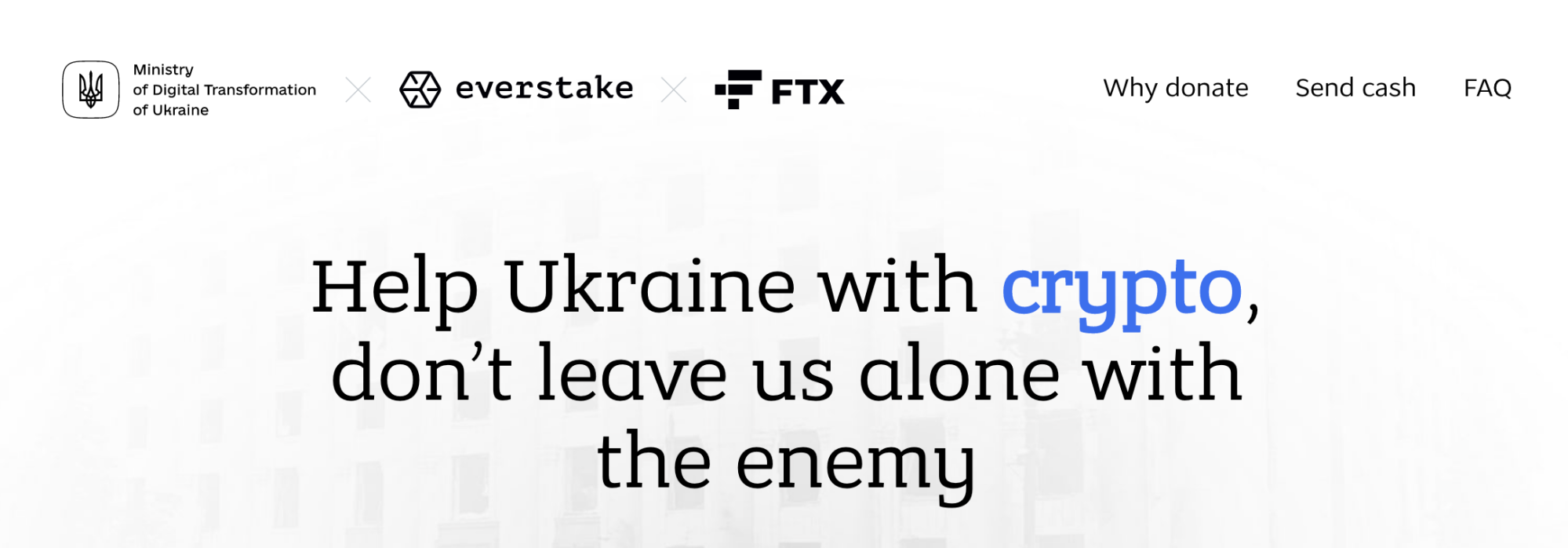No, FTX didn’t funnel Ukraine aid to Democratic candidates
The dramatic and sudden collapse of FTX, one of the world’s biggest cryptocurrency exchanges, was major headline news in its own right. But a case of bad timing involving the U.S. midterm elections and international aide for Ukraine has turned the underpinnings of this tech-world cautionary tale into perfect fodder for right-wing conspiracy theorists.
So how did we get here?
Back in 2019 FTX’s founder, Sam Bankman-Fried, also known as SBF, created his crypto empire and cemented himself in the following years as one of the biggest figures in the industry. Then, in just one week this November, the entire SBF empire crumbled, forcing FTX to file for bankruptcy after billions of dollars were withdrawn from the exchange in light of reports that found its trading firm, Alameda Research, was actually insolvent.
That same week happened to see the Democrats exceed expectations in the elections, squashing the narrative of a “red wave.” Looking for answers to how they underperformed, some conservative pundits and media figures discovered an interesting connection: The failing crypto exchange FTX was a major Democratic donor. It also had partnered with Ukraine for its crypto donation program. Throw in the fact that the Biden administration has increasingly sent more aide to the country in its war with Russia and you have the perfect storm for a right-wing conspiracy theory.
The right’s current thing
It’s not hard to see how this “FTX laundered money through Ukraine to the Democrats” narrative came together:
President Joe Biden is a Democrat. The Biden administration has sent billions of dollars in aide to Ukraine in order to assist the country in the ongoing war that Russian president Vladimir Putin started in February. Ukraine has been a global leader when it comes to crypto adoption.
The Ukrainian government accepted crypto donations when the war started and later launched the Aid for Ukraine program, partnering with a few crypto companies including FTX in order to facilitate the monetary transfers. FTX founder Sam Bankman-Fried spent a lot of money on the midterms, mainly donating to Democratic politicians.
Thus, a conspiracy theory is born claiming the money Biden sent to Ukraine was actually then funneled through FTX to Democratic candidates.
There’s no evidence to support these claims. But that hasn’t stopped right-wing media figures, such as Fox News’ Tucker Carlson, as well as U.S. Congresspeople like Rep. Madison Cawthorn (R-NC) from spreading the conspiracy theory.
What was the FTX – Aid for Ukraine connection really about?
To understand Ukraine’s partnership with FTX, I spoke with Sergey Vasylchuk, CEO of Ukrainian-based blockchain company, Everstake. Vasylchuk is also the co-initiator of the Aid for Ukraine program, helping put it together since it launched in March. He is also one of five people authorized to sign off on the transfer of donated funds from the DAO, or decentralized autonomous organization, that was set up for Aid for Ukraine.
Vasylchuk explained how when Russia’s war in Ukraine first started, he immediately looked into finding ways to help.
“Due to the Martial Law, the banking system in Ukraine was frozen,” he said. “Banks were not able to transact in USD or transact outside the country. So…crypto became one of the tools in order to pay the suppliers to buy all the necessities to support our business.”
Not long after, Vasylchuk and a few others in the Ukrainian crypto industry reached out to Ukraine’s Ministry of Digital Transformation, a fairly new government agency that looks to modernize the country with upstart technologies.
Shortly after Russia invaded, the Ukrainian government shared its crypto wallet addresses online in order to fundraise for supplies. Tens of millions of dollars in cryptocurrency tokens soon flowed in.
“You should understand: The Ministry of Digital Transformation is an experiment,” Vasylchuk said. “It’s not like an agency which sits [atop] a big building. It’s just a few tech guys, like a dozen, right? They were working 25 hours per day without any breaks or weekends.”
And that’s where Aid for Ukraine came in: A crypto initiative started by Ukrainian companies like Vasylchuk’s Everstake and the crypto exchange Kuna. Between the start of the war and April, around $60 million had been donated to Ukraine in cryptocurrencies.

A screenshot of the Aid for Ukraine homepage displaying the FTX logo in March 2022.
Credit: Mashable Screenshot
While some suppliers accepted crypto, Vasylchuk shared, others who were skeptical of crypto wanted fiat currency. And at the time there were hurdles that they needed to go through to transfer large amounts of crypto into fiat currency and then to the National Bank of Ukraine for the government’s use.
“Cross-border payments in Ukraine were restricted or limited due to the martial law,” said Vasylchuk. “FTX had a good reputation, and their legal team developed the entire process, reaching an agreement with the National Bank [of Ukraine], and eventually made the transfer of the donations to Ukraine legally possible.”
“Back in the day, FTX was a major exchange assessed at $32 billion,” Vasylchuk continued. “But most importantly, they were the first to come to our aid.”
The conspiracy theory doesn’t make any sense
Now that the actual connection between FTX and Ukraine has been established, let’s look at the numbers and the transactions. Because, once you do, the conspiracy theory quickly falls apart.
Remember: The claims from the conspiracy theorists are that billions of dollars were laundered. This would mean money was transferred from the Biden administration to Ukraine, and then transferred again — through FTX — to the Democratic Party.

President Joe Biden and Ukrainian President Volodymyr Zelenskyy meet at the White House in September 2021, just months before Russia’s invasion.
Credit: Doug Mills/The New York Times/Bloomberg via Getty Images
However, the Ukrainian government evidently never sent any money to FTX — partly because the program didn’t even require Ukraine to send any money. Crypto donations via the Aid for Ukraine program were sent to FTX so that the now-defunct crypto company could exchange it for U.S. dollars. FTX did this and then immediately transferred the money to the National Bank of Ukraine.
Vasylchuk provided Mashable with copies of the bank transfer statements. The National Bank of Ukraine received two deposits, one on March 7 and another on March 18, from North Dimension Inc., a subsidiary of FTX.
The total amount was a little more than $1.5 million. These numbers were confirmed by the National Bank of Ukraine back in March, months before there was any controversy surrounding FTX’s involvement. The March 11 tweet corresponds with the transfers shown on the bank statements that were shared.
$1.5 million is far from the billions or even hundreds of millions of dollars that the conspiracies allege were laundered.
Vasylchuk explained that once payment limitations in Ukraine were lifted, FTX was no longer integral to the program.
“Afterward, we used [Ukrainian crypto exchange] KUNA and other tools for settlements or fiat conversion,” he said.
According to Vasylchuk, even in his role as “contact person for Aid for Ukraine,” he’s not even sure if he ever even interacted with FTX founder Sam Bankman-Fried himself as things were coordinated in a text messaging app.
“We had a Signal group,” Vasylchuk said. “There were a lot of people, mostly compliance people, in this group. One of them probably was Sam. I didn’t interact with him directly.”

The collapse of Sam Bankman-Fried’s crypto empire has become part of a political conspiracy theory.
Credit: Ting Shen/Bloomberg via Getty Images
Did any donations to Ukraine get lost when FTX collapsed? Vasylchuk said there were some memecoins that had been donated to the wallets that weren’t worth cashing out. In addition, there were some low-valued NFTs that were donated, for which they just never had time to find a buyer. He believes that if anything, no more than a few thousand dollars worth of assets could have possibly been lost.
The Everstake founder also shared that he was an FTX customer as well, a victim of its collapse, having lost $40,000 of his own personal money on the exchange when it went bankrupt.
Blockchains and domain names
One major problem with this conspiracy theory is that those behind it seem unaware of how crypto works. Every transaction on the blockchain is recorded and viewable by the public. This means that any sketchy crypto transactions, of course, would be discoverable on the blockchain. Yet, there has been no proof or evidence offered up by the individuals sharing these conspiracies to back up their claims.
Billions of dollars in crypto being moved around would have caught at least a few eyeballs. There are websites and social media accounts dedicated to tracking crypto transfers from “whales” or those hoarding large amounts of cryptocurrency.
However, even the few attempts to prove the conspiracy fall flat.
On the night of Nov. 11, the same day FTX filed for bankruptcy, the crypto exchange was hacked. The details behind the hack and who was responsible are still unclear. Some did catch a few interesting transactions from the hacker’s account, which has now been labeled “FTX Account Drainer” on the Ethereum network.
A few days after the hack, the FTX Account Drainer sent hundreds of thousands of crypto tokens to the official Ukraine Crypto Donation wallet. For some, that was proof of Ukraine’s involvement with Ukraine. If you actually look at the transactions though, you’ll see the tokens sent to Ukraine weren’t highly-valued Bitcoin or Ether, the tokens sent were of a completely worthless memecoin called “FTX Sucks.” Sending those tokens is the equivalent of trolling.
Another event that conspiracy theorists have focused on involves the Aid for Ukraine domain name.
On Nov. 1, Aid for Ukraine changed its official website URL for the program from “donate.thedigital.gov.ua” to “aid-to-ukraine.io.” Conspiracies quickly spread that there was more than something to this than a simple domain change.
“It was bad timing,” Vasylchuk said of the domain name switch and its proximity to FTX’s fall. “It really was bad timing.”
But still the allegations make no sense. The timing was certainly inconvenient, but the reports that led to FTX’s quick and sudden demise didn’t drop until later that week. And, the Aid for Ukraine website, even with its new domain name, continued to include FTX’s partnership on all of its branding up until just days ago. If the domain switch was some sort of attempt to distance the Ukrainian government from FTX based on insider knowledge of what was about to happen…they didn’t do a very good job.
The domain extension “.gov.ua” at the end of the URL is controlled by the Ukrainian government, which had been a headache for the aid program. “In order to shift DNS or to have some protection, it was a nightmare,” Vasylchuk said. “We’ve had unprecedented attacks on the website, probably from the Russian side, in order to take it down. So we said, ‘hey guys, let’s move to a separate domain, let’s get control of the domain.’ It’s more flexible to protect the site from attacks.”
Mashable reached out to Ukraine’s Ministry of Digital Transformation, but have not yet heard back. However, the agency’s Deputy Minister Alex Bornyakov has shared Everstake and Aid for Ukraine’s joint statement on the conspiracy theories on his Twitter account.
And of course there’s the speculation that FTX and SBF will not be investigated due to these connections with the Democratic Party. Twitter owner Elon Musk has repeatedly spread these theories as well.
“SBF was a major Dem donor, so no investigation,” Musk tweeted.
But Congressional hearings and criminal investigations into FTX are already underway. The FBI has reportedly been in talks with officials in the Bahamas, where SBF resides, to extradite the FTX founder to the U.S. And some Democratic lawmakers who received donations from FTX and SBF have already donated the amount they received to various charities.
FTX’s political donations
FTX did make political donations. Before his company collapsed, SBF was making moves to become the crypto industry’s biggest figure. He had already created a name for himself as the crypto bailout king, swooping in to buy up cryptocurrency companies when they were dying. His next big project, which was already well underway when FTX failed, was to have a hand in crafting crypto policy that would go before U.S. Congress. To do so, SBF started to invest heavily in political contributions.
Much has been made of SBF’s initial claim that he was going to donate $1 billion to political races up to the 2024 elections. He later walked that back. (Partly because he actually didn’t have the money.)
In all, SBF and his Super PACs donated around $40 million for the 2022 midterm elections. The majority of that money did go to supporting Democratic candidates, as SBF became the Dems’ number two donor.
But, even with all of these facts, the right-wing conspiracy falls apart. SBF didn’t just donate to Democrats. He also donated some of that money to Republicans, including Trump-supporting Peter Thiel-backed candidates like JD Vance in Ohio and Blake Masters in Arizona.
Furthermore, a large chunk of SBF’s political donations actually went into the Democratic primaries. And as Forbes points out, one House candidate in Oregon, Carrick Flynn, received a lot of that money, $10.5 million from SBF’s Protect Our Future PAC. Flynn went on to lose his primary race.
And the conspiracy theories never make mention of FTX executive Ryan Salame, who also donated big to campaigns for the midterms — $23.9 million to be exact — and mostly to Republican candidates.
That’s not to say all of this is fine. But the issue isn’t some false Democratic money-laundering conspiracy. It’s that politicians are beholden to industries who play both sides in order to have an outsized say in our government.
Right-wing politics as usual
So why is this conspiracy spreading? Well, the Republican Party basically just blew an easy layup. The 2022 midterms were supposed to usher in a red wave. A “red tsunami,” some were even calling it. Congressional Democratic incumbents and candidates were supposed to lose across the board in a shellacking that was supposed to be a referendum on the Biden administration.
Instead, Democrats actually expanded their hold in the Senate and Republicans barely eked out a majority in the House with only a handful of seats. In state houses, Democrats won majorities that haven’t been seen in decades.
Much like with their 2020 election fraud claims, it seems Republicans have decided to respond to their losses by crying foul, claiming FTX somehow funneled billions of dollars through Ukraine to the Democratic Party. But according to Aid for Ukraine, FTX never had more than $1.5 million in crypto donations to Ukraine, all of which they exchanged into fiat currency and sent to the Ukrainian government.
“I want to thank every American because without the support, Ukraine would probably not be able to resist or even to exist,” Everstake’s Vasylchuk said as we ended our call. But his experience dealing with these conspiracy theories left him clearly rattled. “I just don’t understand American politics. I’m kind of really shocked that this could even happen.”


